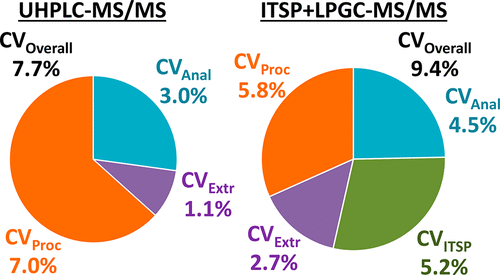当前位置:
X-MOL 学术
›
J. Agric. Food Chem.
›
论文详情
Our official English website, www.x-mol.net, welcomes your
feedback! (Note: you will need to create a separate account there.)
Assessment of Test Portion Sizes after Sample Comminution with Liquid Nitrogen in an Improved High-Throughput Method for Analysis of Pesticide Residues in Fruits and Vegetables.
Journal of Agricultural and Food Chemistry ( IF 5.7 ) Pub Date : 2020-01-16 , DOI: 10.1021/acs.jafc.9b07685 Steven J Lehotay 1 , Nicolás Michlig 2 , Alan R Lightfield 1
Journal of Agricultural and Food Chemistry ( IF 5.7 ) Pub Date : 2020-01-16 , DOI: 10.1021/acs.jafc.9b07685 Steven J Lehotay 1 , Nicolás Michlig 2 , Alan R Lightfield 1
Affiliation

|
In this study, sample processing of bulk commodities using an efficient one-step comminution procedure with liquid nitrogen (LN2) was devised and assessed in the analysis of pesticide residues in fruits and vegetables. LN2 was added to the fresh samples from a tank by opening a valve, and the standard food chopper was kept in a laboratory hood to reduce safety risks. Test portions of four replicates each of 0.25, 0.5, 1, 2, 5, 10, and 15 g were taken from eight fruits and vegetables (tomato, squash, broccoli, apple, grape, peach, green bean, and cucumber) individually comminuted with LN2. For comparison without comminution, similar test portions of a reconstituted freeze-dried certified reference material of pesticides in cucumber were also analyzed by the same method. More than 100 pesticides were monitored by both ultra-high-performance liquid chromatography-tandem mass spectrometry (UHPLC-MS/MS) and instrument top sample preparation (ITSP) + fast low-pressure gas chromatography-tandem mass spectrometry (LPGC-MS/MS). A new version of QuEChERS-based sample preparation was followed, in which 5 mL of 4:1 (v/v) acetonitrile/water per gram of sample is used for extraction and 200 μL of initial extract is quickly evaporated, reconstituted in water, and ultracentrifuged for UHPLC-MS/MS analysis. For ITSP+LPGC-MS/MS, another portion of the initial extract undergoes salt-out partitioning with 4:1 (w/w) anhydrous MgSO4/NaCl and the upper layer extract is transferred to an autosampler vial for automated cleanup and analysis in parallel. Quality control spikes were made during the comminution, extraction, cleanup, and analysis steps to isolate and estimate the individual and overall measurement uncertainties of the approach. The recommended test portion size is 2 g for routine monitoring by this approach, but results demonstrated that subsamples as low as 0.5 g typically gave overall biases and relative standard deviations of <10% for nearly all pesticides, commodities, and methods, which is 3-5% lower than previously evaluated sample processing and analytical methods. This approach can be used to improve data quality, laboratory efficiency, and sample throughput in routine monitoring programs for regulatory, risk assessment, and other purposes.
中文翻译:

用改进的高通量方法分析水果和蔬菜中的农药残留后,用液氮粉碎样品后评估测试部分的大小。
在这项研究中,设计并使用液氮(LN2)有效的一步粉碎程序对大宗商品进行样品处理,并在分析水果和蔬菜中的农药残留时进行了评估。通过打开阀门,将LN2从储罐中添加到新鲜样品中,并将标准食品切碎机保存在实验室通风橱中,以降低安全风险。从八种水果和蔬菜(番茄,南瓜,西兰花,苹果,葡萄,桃,绿豆和黄瓜)中分别切成四份,分别为0.25、0.5、1、2、5、10和15 g的测试部分使用LN2。为了进行比较而不进行粉碎,还通过相同的方法分析了黄瓜中农药复溶冻干认证参考材料的相似测试部分。超高效液相色谱-串联质谱(UHPLC-MS / MS)和仪器顶部样品制备(ITSP)+快速低压气相色谱-串联质谱(LPGC-MS /多发性硬化症)。随后是基于QuEChERS的样品制备的新版本,其中每克样品使用5 mL 4:1(v / v)乙腈/水进行提取,并快速蒸发200μL初始提取物,在水中重新配制,并超速离心进行UHPLC-MS / MS分析。对于ITSP + LPGC-MS / MS,初始提取物的另一部分用4:1(w / w)无水MgSO4 / NaCl进行盐析分配,并将上层提取物转移至自动进样器样品瓶中进行自动清洁和分析平行。在粉碎,提取,净化,分析步骤,以隔离和估计该方法的个体和总体测量不确定性。对于通过这种方法进行常规监测,建议的测试部分大小为2 g,但是结果表明,对于几乎所有农药,商品和方法,低至0.5 g的子样品通常会产生总体偏差和相对标准偏差<10%,为3比先前评估的样品处理和分析方法低-5%。此方法可用于常规监控程序中的数据质量,实验室效率和样品通量的提高,以用于监管,风险评估和其他目的。但是结果表明,低至0.5 g的子样品通常可为几乎所有农药,商品和方法提供总体偏差和相对标准偏差<10%,比先前评估的样品处理和分析方法低3-5%。此方法可用于常规监控程序中的数据质量,实验室效率和样品通量的提高,以进行监管,风险评估和其他目的。但是结果表明,低至0.5 g的子样品通常可为几乎所有农药,商品和方法提供总体偏差和相对标准偏差<10%,比先前评估的样品处理和分析方法低3-5%。此方法可用于常规监控程序中的数据质量,实验室效率和样品通量的提高,以进行监管,风险评估和其他目的。
更新日期:2020-01-29
中文翻译:

用改进的高通量方法分析水果和蔬菜中的农药残留后,用液氮粉碎样品后评估测试部分的大小。
在这项研究中,设计并使用液氮(LN2)有效的一步粉碎程序对大宗商品进行样品处理,并在分析水果和蔬菜中的农药残留时进行了评估。通过打开阀门,将LN2从储罐中添加到新鲜样品中,并将标准食品切碎机保存在实验室通风橱中,以降低安全风险。从八种水果和蔬菜(番茄,南瓜,西兰花,苹果,葡萄,桃,绿豆和黄瓜)中分别切成四份,分别为0.25、0.5、1、2、5、10和15 g的测试部分使用LN2。为了进行比较而不进行粉碎,还通过相同的方法分析了黄瓜中农药复溶冻干认证参考材料的相似测试部分。超高效液相色谱-串联质谱(UHPLC-MS / MS)和仪器顶部样品制备(ITSP)+快速低压气相色谱-串联质谱(LPGC-MS /多发性硬化症)。随后是基于QuEChERS的样品制备的新版本,其中每克样品使用5 mL 4:1(v / v)乙腈/水进行提取,并快速蒸发200μL初始提取物,在水中重新配制,并超速离心进行UHPLC-MS / MS分析。对于ITSP + LPGC-MS / MS,初始提取物的另一部分用4:1(w / w)无水MgSO4 / NaCl进行盐析分配,并将上层提取物转移至自动进样器样品瓶中进行自动清洁和分析平行。在粉碎,提取,净化,分析步骤,以隔离和估计该方法的个体和总体测量不确定性。对于通过这种方法进行常规监测,建议的测试部分大小为2 g,但是结果表明,对于几乎所有农药,商品和方法,低至0.5 g的子样品通常会产生总体偏差和相对标准偏差<10%,为3比先前评估的样品处理和分析方法低-5%。此方法可用于常规监控程序中的数据质量,实验室效率和样品通量的提高,以用于监管,风险评估和其他目的。但是结果表明,低至0.5 g的子样品通常可为几乎所有农药,商品和方法提供总体偏差和相对标准偏差<10%,比先前评估的样品处理和分析方法低3-5%。此方法可用于常规监控程序中的数据质量,实验室效率和样品通量的提高,以进行监管,风险评估和其他目的。但是结果表明,低至0.5 g的子样品通常可为几乎所有农药,商品和方法提供总体偏差和相对标准偏差<10%,比先前评估的样品处理和分析方法低3-5%。此方法可用于常规监控程序中的数据质量,实验室效率和样品通量的提高,以进行监管,风险评估和其他目的。









































 京公网安备 11010802027423号
京公网安备 11010802027423号